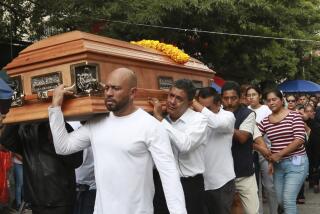Peru Vows Coca Crackdown, Meese Says
- Share via
LIMA, Peru — President Alan Garcia pledged to attack his nation’s enormous coca crop with newly developed aerial herbicides after experiments on their safety and effectiveness are completed, U.S. Atty. Gen. Edwin Meese III said Monday.
Aerial spraying is an extremely sensitive political issue in poverty-ridden Peru, where farmers are growing an estimated 504,000 acres of coca leaf a year, making it by far the nation’s largest cash crop. Narcotics trafficking, primarily in cocaine, accounts for about $700 million annually, or nearly 30% of Peru’s official foreign exchange earnings.
Meese, who is conducting a presidential mission on the Latin cocaine crisis, said that Garcia’s promise is significant because the sometimes difficult Peruvian president has greater ideological differences with the Reagan Administration than the leaders of the other four nations with whom the attorney general is meeting on his weeklong tour of the region.
Wants Leadership Remembered
In a 55-minute meeting with Meese, Garcia said he wants Americans to remember him as the Peruvian president who provided the leadership needed to wipe out the coca plants.
A beaming Meese called Garcia’s remarks “the most significant statement of support” he had received from South American leaders thus far on their willingness to deal with the cocaine problem. In addition to eradication efforts, Meese and Garcia discussed expansion of Peruvian police efforts against cocaine laboratory and production facilities.
Limited manual eradication efforts by Peru’s police and military forces have had little success, particularly with the hundreds of thousands of acres of coca crop in the Upper Huallaga Valley.
Efforts against the crop in the valley and in other remote areas have been hampered by the military’s need to cope with terrorist organizations, including the Maoist Sendero Luminoso (Shining Path) and the Tupac Amaru Revolutionary Movement.
Meese said the herbicide being considered for use in Peru, known as tebuthurion, is already being widely applied in the Southwest United States to clear brush. He said the chemical is being tested with Peruvian soil brought to U.S. laboratory facilities, adding that initial results of field tests show it to be effective.
According to State Department estimates, Peru could eradicate 24,000 acres of cocaine a year with effective and safe aerial herbicides. If the herbicide is available by the beginning of 1989, which Meese said is possible, Peru could eradicate at least one-tenth of its coca crop.
Meese and Garcia also discussed another potential weapon in the cocaine battle that has never been used--the U.S.-Peru extradition treaty on narcotics offenses.
May Strengthen Pact
The two men talked about the possibility of strengthening the pact, and Garcia indicated that he is willing to negotiate another type of treaty under which assets of drug traffickers could be seized and the two nations could cooperate in conducting financial investigations of narcotics violators.
The attorney general made his comments on the Garcia meeting to reporters en route to Bolivia, the last of the five South American countries he is visiting. But even as his Latin American tour reached its final stage, Meese continued to be dogged by questions over his legal problems back home.
At a press conference in Lima, when asked about his personal plans through the end of the year, Meese said he intends to continue his duties “as I am here, until such time as I decide to leave the government.”
Aides to Meese said that the attorney general did not mean to indicate that he plans to leave before the end of the Reagan Administration, though one noted that Meese said in a statement at least six months ago that he would consider a teaching position if the right one were offered.
More to Read
Sign up for Essential California
The most important California stories and recommendations in your inbox every morning.
You may occasionally receive promotional content from the Los Angeles Times.










